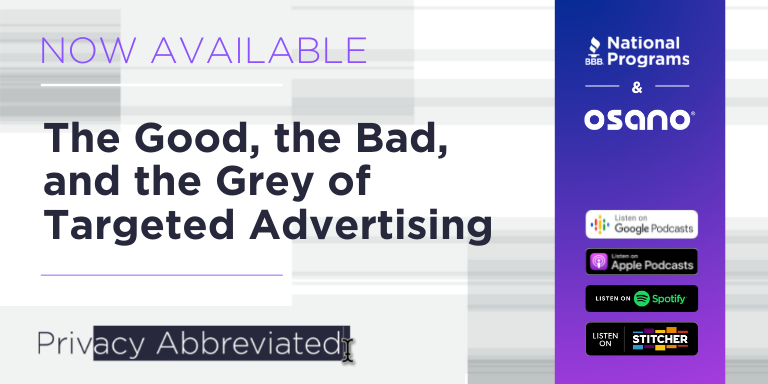
Show Notes: The Good, the Bad, and the Grey of Targeted Advertising
00:00 – In episode two of Privacy Abbreviated, hosts Dona Fraser, Senior Vice President of Privacy Initiatives at BBB National Programs, and Catherine Dawson, General Counsel and Chief Privacy Officer of Osano, walk listeners through how to target responsibly. Some consumers love the personalization it delivers to their social media feeds, while others are concerned that it’s an invasion of privacy. With their guest, they discuss how to use targeted advertising responsibly, using data to track consumers and display ads for products they have previously shown interest in, and how marketers should prepare for the American Data Protection and Privacy Act.
03:28 – This episode, their guest is the Founder and CEO of I Hear Everything and host of the MarTech Podcast, Benjamin Shapiro. I Hear Everything is a New Media company that connects brands and content creators with their audiences. Ben is an experienced entrepreneur and marketing consultant.
05:20 – Dona kicks off the interview by asking what Ben sees as the biggest challenge for small and medium business (SMB) marketers. He notes that a major difficulty is the differences in privacy requirements depending on location and marketing activity. He brings up the difference between first and third party data. First party data is from someone who has willingly offered their information by filling out a form and may be used in various ways; whereas third party data, which is customer data that has been purchased.
07:07 – Marketers are beginning to rely more on that first party data. Not only does it ensure that members of their audience are truly interested in the products or services advertised, but companies can also utilize the data, knowing they are not overstepping or breaking the law. This has become increasingly important as governments pass stricter privacy laws such as the General Data Protection Regulation in Europe and the California Consumer Privacy Act.
08:59 – Additionally, platforms like Apple and Facebook are also giving users more control over the data they allow to be tracked. This has caused performance marketing and third party data to become less effective. Facebook, in particular, used to know about 90% of all platform users’ information and behaviors. New privacy settings and consent requirements have reduced that number to about 30%, according to Ben. In lieu of performance marketing, advertisers are turning to two different strategies: content marketing and influencer marketing. Content marketing is producing valuable content that drives consumers to a website and encourages them to opt-in to allow cookies. Influencer marketing is a partnership with another brand or individual to draw leads from their existing audience.
11:08 – Catherine notes that many consumers feel conflicted about targeted advertising. While it may be convenient and beneficial to see relevant ads, this also may also feel like a breach of privacy. Many may not want businesses to see their online activity. She asks how to walk the line by providing value to prospective customers without being intrusive.
12:15 – Ben answers by using the marketing funnel as an example. It is a valuable tool for measuring consumer interest. A prospective customer at the widest part of the funnel, someone who has only just learned about a brand, will be far less interested in receiving repetitive targeted ads than a consumer who interacts with a brand multiple times a week.
18:33 – However, he also discusses the difficulty of tracking multiple touches across different platforms. Even sophisticated software has yet to master this level of analysis. Instead, the most reliable data is the final touch that leads a prospect to become a customer. If it was an ad on LinkedIn, that data indicates LinkedIn ads are successful. It is imperfect data, which makes it difficult for businesses to understand when audiences begin to feel fatigued by a campaign. As marketing platforms become more sophisticated, marketers will start to gain a better understanding of frequency caps.
21:00 – Addressing Dona’s next question about how to use targeted advertising without it becoming “surveillance advertising,” Ben explains that, as a consumer, he appreciates targeted advertising. He would prefer personalized ads over ads that he feels are irrelevant to him. He recognizes that he sits at one end of the spectrum, and other consumers might feel differently. Especially in the wake of the Facebook-Cambridge Analytica scandal and political controversy, many have come to fear targeted advertising. But he believes that much of this fear is unnecessary. “The average marketer doesn’t care what time you wake up and when you’re home,” he says. “He wants you to buy their T-Shirt.”
30:51 – To close the interview, Dona asks Ben for advice to prepare marketers for the next evolution of advertising. He leaves listeners with these sentiments:
- The third-party cookie is dying. This is due to emerging privacy laws and marketing platforms’ new consumer-consent approach. Tracking audiences without permission will continue to become more difficult and less informative.
- Begin developing content right away. Those who aren’t preparing for the new environment now will be behind when it comes. Be prepared for the next step and understand how your customers are willing to engage.
- Give customers a reason to want to opt-in. Blog posts, communities, and podcasts are all great ways to encourage an audience to opt-in to targeted advertising. Providing value in exchange for contact information helps to remove the “creep factor” from targeting.
Explore BBB NP’s Privacy Initiatives
Subscribe To Never Miss An Episode
Listen to the complete episode here.

